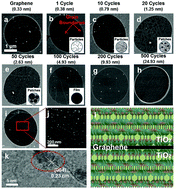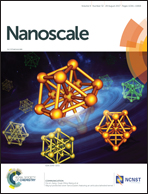Role of graphene in enhancing the mechanical properties of TiO2/graphene heterostructures†
Abstract
Graphene has been integrated in many heterogeneous structures in order to take advantage of its superior mechanical properties. However, the complex mechanical response of heterogeneous films incorporating graphene is not well understood. Here, we studied the mechanical behavior of atomic layer deposition (ALD) synthesized TiO2/graphene, as a representative building block of a typical composite, to understand the mechanical behavior of heterostructures using an experiment-computational approach. The inclusion of graphene was found to significantly enhance the Young's modulus of TiO2/graphene hetero-films for films below a critical thickness of 3 nm, beyond which the Young's modulus approaches that of pure TiO2 film. A rule-of-mixtures was found to reasonably estimate the modulus of the TiO2/graphene hetero-film. Experimentally, these hetero-films were observed to fail via brittle fracture. Complimentary density functional theory and finite element modeling demonstrates strong adhesion at the graphene TiO2 interface and that graphene serves as a reinforcement, providing the hetero-film with an ability to sustain significantly high stresses at the point of failure initiation. The results and methodology described herein can contribute to the rational design of strong and reliable ultrathin hetero-films for versatile applications.



 Please wait while we load your content...
Please wait while we load your content...